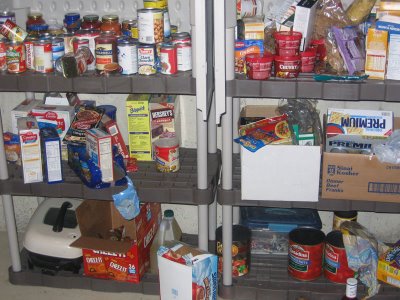Musing among cans, boxes, bags & pouches
For weeks, my wife Patty has begged me to bring some structure to two particularly daunting shelving units of groceries in our basement. For weeks, I've intended to do just that. A week or so ago, she switched to Plan B -- ask two of our children to tackle the job. Out of respect for the kids' creativity and intellect, she didn't set a lot of parameters, other than to insist all items find their way off the floor. We sat back with smiles, hopeful that peaches and fruit cocktail, pasta and rice side dishes, and myriad other buried items would at last be married with their appropriate counterparts.
Here's the end result of the kids' work:

Yes, there are still items on the floor, and yes, there are items actually dangling off the shelves. Creative, no?
After some reflection, my wife has returned to Plan A, and I have returned to my ambition to get around to this within the next few weeks--unless a viable Plan C emerges. Unbeknownst to my wife, the whole process got me thinking again about how people approach organizing diverse information (or boxes of Hamburger Helper), and about how we might each approach the same task in an entirely different way.
When I work with a client to establish their web site taxonomy, or to create a process or strategy map, I need to consider both how the organization wants that information to be structured and how individual employees will be most receptive to that information. To succeed, I need to turn off my preconceived notions of how I would process that data, and instead find the most logical sequence for that time and that audience. So, if I am helping to plan a site architecture, I need to understand the goals for the effort, how other information is structured, how this information is currently structured, what options exist for reorganizing information and as much else I can glean about the organization and its specific needs. How many of these types of questions do you think the kids asked in facing their challenge?
Think for a moment how you might order the contents of my shelves. Some of you might arrange by type of container -- cans, bottles, boxes and pouches could each have their own shelf. You might arrange by the contents of the package -- vegetables in one section, fruit in another, and so on with soup, prepared meals and the like. If you're a real control freak, you might group the items by the meals you hope to create with them -- if you do, though, you've got way too much time on your hands. You may order them by the meal they are most likely to support -- syrup and corned beef hash in a breakfast section? Or, if you're feeling really adventurous, you could organize the items the ways my sons did -- chaos, anyone? The bottom line is this -- the only way you could know what would work for me is to make sure you ask questions. If you don't ask the questions, your system may not serve my needs any better than my sons' system did.
Sometimes, your questions should extend beyond the immediate environment. For example, should some of the items be discarded or given away? Should some be moved to the upstairs pantry, so they are closer at hand and therefore more likely to be used? Should we stock up on more items that will make these items more appealing? Would a jar of gravy help move mashed potatoes more quickly? Should we create a written inventory of items, and match that item with a grocery list, so we know exactly what we have at any given point in time? How else might a more holistic view reduce future challenges?
Consultants are guilty, at times, of proposing their own best solution, instead of asking the probing questions about what works best for the client. In the field of visual communication, this is a risky presumption. If you send out a message that the audience is unprepared to receive, your message will likely be lost, no matter how much finesse you applied to its creation. If you organize the information in a way that does not put the most appropriate messages up front, the overall message may be hopelessly muddled. Suppose you are introducing a new sales compensation program; if you put the wrong information up front and push important details to the "back of the shelf", you run a very real risk of creating a full-blown morale issue. You need to ask questions, and then ask questions about the answers you receive, until you have a pretty clear picture of what will work. It's still true that if you assume, you make an...well, you get the idea.
Incidentally, I plan to organize the items on the shelves by their appropriateness to my lifestyle at this point in time. I'm trying to lose weight and get in better shape, so the whole grains and low-fat ingredients will occupy a different shelf than the refined goods. Would you have guessed that? Probably not. If you bought more groceries six months from now, could you be sure that the system hadn't changed? Again, probably not. That's why we cannot afford to guess, especially when questions can provide such a wealth of information.
Does anyone have a Plan C for me?
Cheers,
Brian


1 Comments:
I use plan 'C' in my household, my partner wants the pantry shelves organized, my partner organizes it.
The person with the most passion for the task should take on the task.
Post a Comment
<< Home